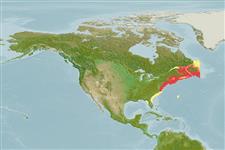分类 / Names
俗名 | 同种异名 | Catalog of Fishes(属, 种) | ITIS | CoL | WoRMS | Cloffa
Teleostei >
Clupeiformes (Herrings) >
Alosidae (Shads and Sardines)
Etymology: Alosa: Latin, alausa = a fish cited by Ausonius and Latin, halec = pickle, dealing with the Greek word hals = salt; it is also the old Saxon name for shad = "alli" ; 1591 (Ref. 45335); sapidissima: sapidissima meaning most delicious (Ref. 1998).
Environment: milieu / climate zone / depth range / distribution range
生态学
海洋; 淡水; 半咸淡水; 溯河洄游 (Ref. 51243); 深度上下限 0 - 250 m (Ref. 6793). 溫帶; 54°N - 28°N, 84°W - 52°W (Ref. 86798)
North America: Atlantic coast from Labrador, Canada to St. Johns River, Florida, USA; ascends coastal rivers during spring spawning migrations. Introduced into Sacramento River, California in 1870s and has spread along Pacific Coast from Kamchatka, Russia to Todos Santos Bay, Mexico. Landlocked in Millerton Lake, California, USA.
北美洲: 紐芬蘭 (參考文獻 1998) ,聖勞倫斯河與新斯科舍省向南至中央的佛羅里達。 由於引入進入薩克拉門托河與哥倫比亞河, 這種現在在從阿拉斯加的庫克溪 (參考文獻 1998) 到墨西哥的下加利福尼亞與堪察加半島被發現。
Length at first maturity / 大小 / 重量 / 年龄
Maturity: Lm 43.4, range 38 - 48.5 cm
Max length : 76.0 cm TL 雄鱼/尚未辨别雌雄; (Ref. 6885); 61.7 cm SL (female); common length : 50.0 cm SL 雄鱼/尚未辨别雌雄; (Ref. 188); 最大体重: 5.5 kg (Ref. 7251); 最大年龄: 13 年 (Ref. 72462)
背棘 (总数) : 0; 背的软条 (总数) : 15 - 19; 臀棘: 0; 臀鳍软条: 18 - 24; 脊椎骨: 51 - 60. Moderately compressed, belly with a distinct keel. Lower jaw not rising steeply within mouth. Gill rakers long and slender (fewer in young). Silvery in color with blue or blue-green metallic luster on back (Ref. 1998). A dark spot on shoulder, sometimes followed by several more, or even a second row. Resembles A. pseudoharengus with lower jaw rising steeply within mouth, eyes larger, and fewer lower gill rakers, as also A. aestivalis and A. mediocris (Ref. 188). Silvery, with a green or bluish back (Ref. 7251). Branchiostegal rays 7 (Ref. 4639).
中等侧扁, 腹面有一个明显的龙骨脊。 下颌不陡升在嘴里面。 鳃耙长且细的.(比较少的当幼鱼时) 银色的颜色有蓝色的或背面的蓝绿色金属的光彩.(参考文献 1998) 在肩上的一个深色斑点,有时跟随着一些更多, 或甚至第二个列。 用下颌与 A. pseudoharengus 相似陡升在嘴里面, 眼比较大的, 与较少的下鳃耙, 当也 A. aestivalis 与 A. mediocris.(参考文献 188) 银色的, 具有一个绿色或蓝色的背面.(参考文献 7251) 鳃条骨 7.(参考文献 4639)
Spends most of its life at sea, returning to freshwater streams to breed (Ref. 27547). Inhabits open water of large rivers (Ref. 86798). Non-spawning adults are found in schools near the surface of continental shelf waters in spring, summer and fall (Ref. 7135); also found in brackish waters (Ref. 4607). Newly hatched larvae are found in rivers during the summer; by autumn they enter the sea and remain there until maturity. Juveniles form schools at 20-30 mm TL and gradually move downstream (Ref. 4639). Feeds on plankton, mainly copepods and mysids, occasionally on small fishes. Feeding ceases during upstream spawning migration and resumes during the downstream post-spawning migration (Ref. 1998). Commercially caught in rivers and estuaries during spawning migration (Ref. 1998). Utilized fresh, salted, or smoked. The roe is esteemed. Eaten pan-fried, broiled, and baked (Ref. 9988). Possibly to 375 m depth (Ref. 6793). Parasites found are nematodes, Acanthocephala, copepods and distomes (Ref. 37032).
在海上渡过它生命期的大部份, 回到淡水溪流到繁殖。 (参考文献 27547) 非产卵期的成鱼被发现于大陆架水域的鱼群接近水表面在春天、夏天与秋天;(参考文献 7135) 也发现于半咸淡水域。 (参考文献 4607) 最近孵化了仔鱼在夏天期间被发现于河; 在秋天之前,他们进入海洋而且逗留在哪里到成熟。 稚鱼在 20-30 mm TL 时形成鱼群,而且逐渐地移动顺流而下。 (参考文献 4639) 捕食浮游生物, 主要地桡脚类的动物与糠虾, 偶然地捕食小鱼。 进食在向上游产卵迁移的时候停止而且在向下游的产卵后洄游的时候重新。 (参考文献 1998) 在产卵迁移的时候商业上捕获于河与河口。 (参考文献 1998) 生鲜使用, 盐腌的, 或烟熏。 鱼白被赞赏。 被吃油锅炸的, 烤的与烘乾的.(参考文献 9988) 可能地对 375 公尺深.(参考文献 6793) 发现的寄生虫是线虫类,棘头虫,桡脚类的动物与双盘吸虫。 (参考文献 37032)
Some shad spawn immediately on entering fresh water while others may undertake fairly long journeys, as much as 630 km upstream, to their favored spawning grounds (Ref. 4607). Enters rivers as early as November (Florida) and as late as May or June in the north, depending on water temperature (peak runs at about 18.5 °C). Spawning occurs at sundown and continues until after midnight. The fish pair and swim close together, releasing eggs and milt (Ref. 27547). Adults descend shortly after spawning, the young in the autumn.
Spawning reported from 8-26°C, generally occurs at 12-21°C (Ref. 38954).北美洲: 紐芬蘭 (參考文獻 1998) ,聖勞倫斯河與新斯科舍省向南至中央的佛羅里達。 由於引入進入薩克拉門托河與哥倫比亞河, 這種現在在從阿拉斯加的庫克溪 (參考文獻 1998) 到墨西哥的下加利福尼亞與堪察加半島被發現。
Whitehead, P.J.P., 1985. FAO Species Catalogue. Vol. 7. Clupeoid fishes of the world (suborder Clupeoidei). An annotated and illustrated catalogue of the herrings, sardines, pilchards, sprats, shads, anchovies and wolf-herrings. FAO Fish. Synop. 125(7/1):1-303. Rome: FAO. (Ref. 188)
人类利用
渔业: 商业性; 游钓鱼种: 是的
工具
特别资料
下载 XML
网络资源
Estimates based on models
Preferred temperature (Ref.
123201): 0.5 - 11.5, mean 5.6 °C (based on 113 cells).
Phylogenetic diversity index (Ref.
82804): PD
50 = 0.5000 [Uniqueness, from 0.5 = low to 2.0 = high].
Bayesian length-weight: a=0.00646 (0.00356 - 0.01171), b=3.00 (2.85 - 3.15), in cm total length, based on LWR estimates for this species & Genus-body shape (Ref.
93245).
营养阶层 (Ref.
69278): 3.5 ±0.3 se; based on diet studies.
Generation time: 5.5 ( na - na) years. Estimated as median ln(3)/K based on 1
growth studies.
回复力 (Ref.
120179): 低的, 最小族群倍增时间4.5 - 14 年 (K=0.14; tm=4.7).
Fishing Vulnerability (Ref.
59153): Moderate to high vulnerability (50 of 100).
Climate Vulnerability (Ref.
125649): Moderate vulnerability (44 of 100).
Nutrients (Ref.
124155): Calcium = 19.3 [10.1, 94.6] mg/100g; Iron = 1.41 [0.61, 3.68] mg/100g; Protein = 19.9 [17.4, 22.6] %; Omega3 = 0.77 [0.41, 1.51] g/100g; Selenium = 30.3 [16.6, 55.9] μg/100g; VitaminA = 10.2 [2.6, 43.4] μg/100g; Zinc = 0.412 [0.273, 0.736] mg/100g (wet weight); based on
nutrient studies.
